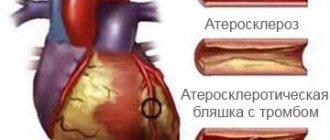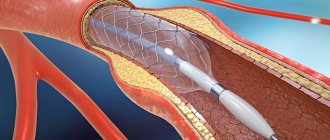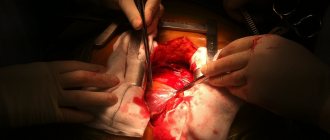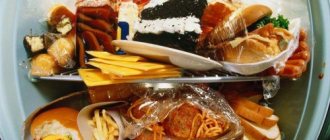Diet after stenting
Proper nutrition after stenting is both an integral part of the treatment and the prevention of further heart problems. Not all patients adhere to the recommendations for proper nutrition. And this plays a big role in the high rate of recurrent angina and repeated stenting. Diet therapy after stenting is aimed at reducing the caloric content of food and includes the following: Restriction of animal fats in the diet - hypocholesterol diet. This means reducing the consumption of cholesterol: fatty meats (lamb, pork), lard, liver and other offal, sausages, and semi-finished products. You should not eat butter, cheese, sour cream, or cream in large quantities. also worth limiting your egg consumption to 3-4 eggs per week. All fatty foods are a source of cholesterol, which contributes to the growth of plaques in blood vessels and the progression of atherosclerosis, due to which the symptoms of coronary heart disease will resume after stenting. Limiting carbohydrates (sweets). From the products that are often on our table, we will have to cross out sweets: confectionery, white bread, carbonated drinks, ice cream, etc. In the body, carbohydrates are converted into fats that are harmful to blood vessels and the heart. That is why you should give up sweets as much as possible. It is better to replace sweets with dried fruits. Limiting foods containing high amounts of salt . It causes fluid retention in the body and increased blood pressure. Many patients with coronary artery disease who undergo stenting have hypertension. They should pay particular attention to this recommendation. The amount of salt should be reduced to 3-4 g per day (half a teaspoon). Be careful: many prepared foods (canned food, bread, etc.) contain salt, so you should limit its consumption more or less depending on what foods are present in your diet. Limiting the consumption of coffee and other drinks and products containing caffeine ( strong tea, chocolate, cocoa ).
Caffeine causes vasospasm and increases heart function. The cardiovascular system works under load, which is harmful to patients with coronary artery disease and stenting. However, the diet does not require a complete abstinence from coffee. If blood pressure is controlled and there are no symptoms, it can be consumed in small quantities. The basis of the diet should be vegetable oils, fresh fruits, high-fiber vegetables, seaweed, fish (consumed at least 2 times a week), seafood, whole grains, wholemeal brown bread, nuts, legumes, lean meat and poultry. , low-fat dairy products. All these products prevent the development of atherosclerosis. Dietary fiber from plant foods binds and removes cholesterol from the intestines, omega-3-polyunsaturated fatty acids from fish and vegetable oils reduce the content of harmful lipids (low-density lipoproteins, triglycerides) in the blood and increase the content of beneficial ones (high-density lipoproteins).
Recommended Products
To lower the level of cholesterol in the blood and minimize the risk of developing atherosclerosis, ischemia and angina, it is necessary to include in the diet foods containing complex carbohydrates, fiber and polyunsaturated fatty acids. The daily menu should include:
- berries, vegetables and fruits;
- fresh herbs;
- dairy products;
- lean fish;
- seafood (seaweed, mussels);
- vegetable oil (olive or sunflower);
- poultry meat (chicken, turkey);
- lean meats (lamb, veal, lean beef);
- vegetable soups;
- cereal crops.
Decoctions of wheat bran and rose hips have a good effect on cardiac activity and blood circulation. Vegetable and berry juices are also useful.
What happens if you don't follow the rules?
Arterial stenting procedures are considered quite difficult, so to achieve lasting results you need to follow a certain lifestyle. More precisely, diet after stenting of the coronary vessels of the heart is the most important component of therapy during the rehabilitation period.
Proper organization of nutrition after surgery will prevent the re-development of angina and additional vascular operations.
Nutritional risk factors for the secondary development of atherosclerosis, coronary heart disease, and surgical procedures include:
- High energy value of dishes, which provokes obesity.
- Consumption of excess amounts of cholesterol under the condition of a deficiency of products that normalize its metabolism.
- Lack of fatty acids that normalize cholesterol metabolism, reducing its deposits on vascular walls.
For full recovery, medical recommendations include reducing stressful situations and regularly taking prescribed medications. After rehabilitation, it is important to regularly attend preventive examinations.
Diet by day
Based on the permitted products, a sample menu after stenting the coronary vessels of the heart will look like this:
- It's better to start the day with a breakfast of buckwheat porridge with milk. For dessert, you can eat oatmeal cookies, washed down with weak tea. A slice of lemon will help add flavor to the drink.
- Second breakfast may include cottage cheese casserole, carrot and apple salad and a protein omelet.
- For lunch, vegetable broth, mashed potatoes with a small piece of chicken are best. Eating a vegetable salad with herbs is also encouraged.
- For an afternoon snack, it is recommended to choose dried fruits (dried apricots, raisins, dates).
- For dinner, boil rice, prepare a beet salad and a white fish steak.
3 hours before bedtime, drink a glass of low-fat kefir. You will have to give up late snacks.
Figures and facts
People who have had a heart attack have a higher risk of new cardiovascular events than those who have a healthy heart. Lifestyle changes can significantly reduce your risk. According to statistics, effective prevention of recurrent cardiovascular events through lifestyle changes saves 80,000 lives per year in the United States alone!
According to research, quitting smoking, regular physical activity and diet correction reduce mortality by 20-35%. However, despite such a powerful preventive effect, not all people are in a hurry to switch to a special diet after a myocardial infarction. It is known that only 43.4% of patients with cardiovascular diseases in high-income countries and 25.8% in low-income countries adhere to the principles of a healthy diet. Even after receiving full information about the importance of diet correction and the basic requirements for changing it, many patients simply reduce the caloric content of foods and continue to eat incorrectly. At the same time, the principles of healthy eating are simple both to understand and to implement.
Is it necessary to contact a nutritionist or can you create a diet yourself?
Cardiologists strongly recommend contacting nutritionists with appropriate qualifications, who will select a suitable diet for each patient individually. Each person's body is unique, and there is no universal diet. Moreover, many patients are convinced that the diet means serious restrictions and a very meager menu. A nutritionist will help you create a varied, nutritious diet so that proper nutrition does not cause discomfort.
Authorized Products
After myocardial infarction and coronary artery stenting, the daily menu must include:
- vegetables, fruits, berries;
- nuts, beans, greens;
- homemade fermented milk products;
- lean fish, seafood (seaweed, mussels, shrimp);
- unrefined vegetable oil (preferably olive, flaxseed);
- chicken, turkey;
- lean meat - veal, beef tenderloin;
- whole grain cereals.
Important! You should not buy low-fat fermented milk products. They are significantly inferior in taste, are repeatedly processed, and contain a lot of synthetic additives.
Prohibited Products
Men and women who have had a stent or heart attack should completely avoid:
- coffee, cocoa, chocolate, spices;
- fatty fermented milk products - cheese, sour cream, cream;
- fatty meat, fish;
- puff pastries;
- mushrooms and even mushroom broths;
- canned, smoked products;
- mayonnaise, margarine, butter.
It is also worth removing from the menu store-bought sauces, sausages, various chips, crackers, nuts and other products that are not recommended for consumption even by absolutely healthy people.
Foods to eat in moderation
The menu after stenting and heart attack may contain the following products, but in limited quantities:
- semolina, rice cereal;
- whole grain pasta, bran bread;
- honey, sugar;
- grapes, raisins, bananas.
This is a difficult food for the body, the consumption of which should be minimized.
Secrets of cooking healthy food3
A healthy diet is not just about lots of fruits, vegetables, fish and whole grains. This is also the correct heat treatment of dishes, which allows you to preserve the beneficial properties of the products.
How to fry correctly?
- Instead of frying the meat in a pan, it is better to wrap the meat in foil and bake in the oven or grill. It is better to do the same with fish and poultry.
- For frying, you should use sunflower and olive oil. To reduce the amount of oil soaked in food, use a non-stick frying pan.
- It is important to trim the fat from meat before cooking.
How to stew correctly?
- Use minimal salt.
- Refrigerate food immediately after cooking. The fat will harden on the surface, after which it can be removed.
What products are better to choose?
- Use low-fat lactic acid products and natural sugar-free yogurt
- Replace sour cream or mayonnaise with reduced-fat cottage cheese or natural low-fat yogurt
- Give preference to low-fat cheeses
- Use olive and other vegetable oils instead of cooking fats
- Choose lean meat and poultry without skin.
Early postoperative period
Wound care. Typically, postoperative sutures do not require removal, and the wound does not require special care. The doctor may recommend that you treat the wound with brilliant green for several days, in most cases this is enough. However, you need to protect the wound from injury, avoid rubbing the wound with clothing, and avoid hypothermia.
Shower. If sutures are not required or are removed, you can shower. Hot showers are not recommended. The wound is washed with warm water without using a washcloth. After washing, you need to blot the wound area with a towel, do not rub! After the wound has dried, you can treat it with brilliant green.
Mode. During the first month after surgery, a gentle regime is necessary. The wound must heal, and the body “get used” to the new features of the blood supply. Therefore, physical activity, baths, saunas, hypothermia are not recommended, and alcohol intake should be completely avoided.
Medicines. After the operation, you will be prescribed medications. Strictly follow the regimen and dosage. More information about medications will be discussed below.
Additional recommendations
Patients with cardiovascular problems should avoid alcoholic beverages. It has been proven that excessive alcohol consumption significantly increases the risk of developing cardiomyopathy, arterial hypertension, arrhythmia, and stroke. The maximum permissible daily alcohol intake is 100 ml of wine\30 ml of spirits. Smoking is strictly contraindicated. It puts a tremendous burden on all systems of the body, including the cardiovascular system. If you cannot quit cigarettes on your own, contact your doctor. He will help you choose the correct nicotine replacement therapy - patches, chewing gum, etc., thanks to which you will be able to give up your addiction without stressing the body.
Moderate physical activity plays an important role. You need to spend at least 30 minutes a day outdoors. Strength exercises are contraindicated for patients with cardiovascular problems. It is recommended to practice Nordic walking or swimming.
If after stenting or a heart attack you experience discomfort in the heart area, shortness of breath and other unpleasant symptoms, consult a doctor immediately.
Prohibited Products
After stenting surgery, patients should completely limit their consumption of the following foods:
- coffee;
- cocoa;
- spices;
- chocolate;
- dairy products with high fat content (cream, sour cream, etc.);
- fatty meats (beef, pork);
- fatty fish (sardines, sprats, etc.);
- products made from puff pastry and butter dough;
- meat, mushroom, fish broths;
- canned and smoked foods;
- mayonnaise, margarine, butter.











